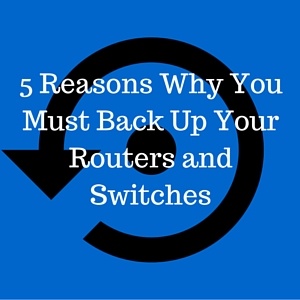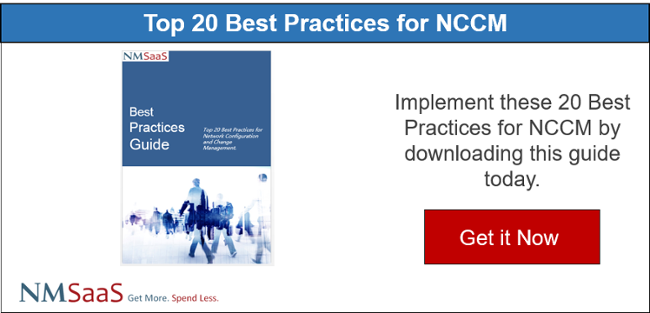I’ve been working in the Network Management business for over 20 years, and in that time I have certainly seen my share of networks. Big and small, centralized and distributed, brand name vendor devices in shiny datacenters, and no-name brands in basements and bunkers. The one consistent surprise I continue to encounter is how many of these organization (even the shiny datacenter ones) lack a backup system for their network device configurations.
I find that a little amazing, since I also can’t tell you the last time I talked to a company that didn’t have a backup system for their servers and storage systems. I mean, who doesn’t backup their critical data? It seems so obvious that hard drive need to be backed up in case of problems –and yet many of these same organizations, many of whom spend huge amounts of money on server backup, do not even think of backing up the critical configurations of the devices that actually move the traffic around.
So, with that in mind, I present 5 reasons why you must back up your Routers and Switches (and Firewalls and WLAN controllers, and Load Balancers etc).

- Upgrades and new rollouts. Network Devices get swapped out all of the time. In many cases, these rollouts are planned and scheduled. At some point (if you’re lucky) an engineer will think about backing up the configuration of the old device before the replacements occurs. However, I have seen more than one time when this didn’t happen. In those cases, the old device is gone, and the new devices need to be reconfigured from scratch – hopefully with all of the correct configs. A scheduled backup solution makes these situations a lot less painful.
- Disaster Recovery.
This is the opposite of the simple upgrade scenario. The truth is that many times a device is not replaced until it fails. Especially those “forgotten” devices that are on the edge of networks in ceilings and basements and far flung places. These systems rarely get much “love” until there is a problem. Then, suddenly, there is an outage – and in the scramble to get back up and running, and central repository of the device configuration can be a time (and life) saver.
- Compliance
We certainly see this more in larger organizations, but it also becomes a real driving force in smaller companies that operate in highly regulated industries like banking and healthcare. If your company falls into one of those categories, then chances are you actually have a duty to backup your devices in order to stay within regulatory compliance. The downside of being non-compliant can be harsh. We have worked with companies that were being financially penalized for every day they were out of compliance with a number of policies including failure to have a simple router / switch / firewall backup system in place.
- Quick Restores.
Ask most network engineers and they will tell you – we’ve all had that “oops” moment when we were making an configuration change on the fly and realized just a second after hitting “enter” that we just broke something. Hopefully, we just took down a single device. Sometimes it’s worse than that and we go into real panic mode. I can tell you, it is that exact moment when we realize how important configuration backups can be. The restoration process can be simple and (relatively) painless, or it can be really, really painful; and it all comes down to whether or not you have good backups.
- Policy Checking.
One of the often overlooked benefits of backing up your device configurations, is that it allows an NCCM systems to then automatically scan those backups and compare them to known good configurations in order to ensure compliance to company standards. Normally, this is a very tedious (and therefore ignored) process – especially in large organizations with many devices and many changes taking place. Sophisticated systems can quickly identify when a device configuration has changed, immediately backup the new config, and then scan that config to make sure it’s not violating any company rules. Regular scans can be rolled up into scheduled reports which provide management with a simple but important audit of all devices that are out of compliance.
Bottom Line:
Routers, Switches and Firewalls really are the heart of a network. Unless they are running smoothly, everything suffers. One of the simplest yet effective practices for helping ensure the operation of a network is to implement an automatic device configuration backup system.


